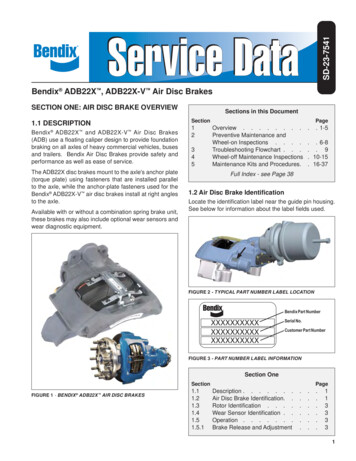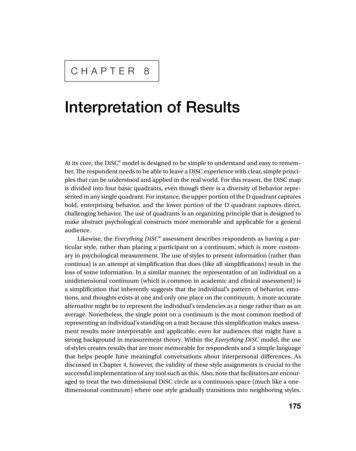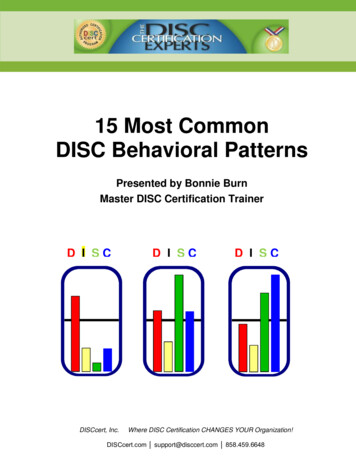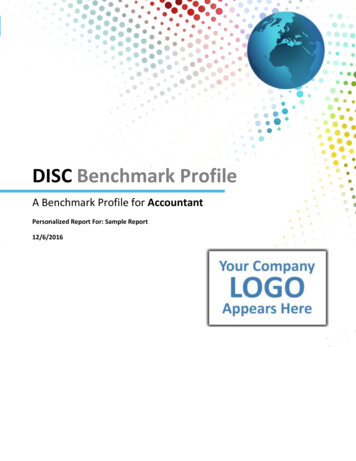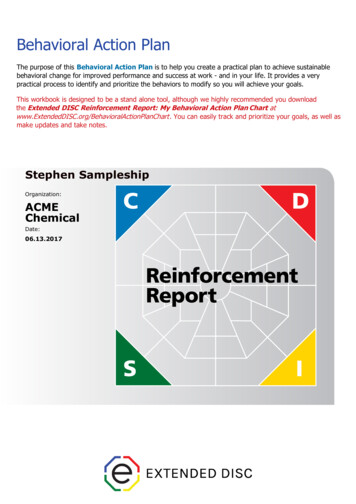
Transcription
Behavioral Action PlanThe purpose of this Behavioral Action Plan is to help you create a practical plan to achieve sustainablebehavioral change for improved performance and success at work - and in your life. It provides a verypractical process to identify and prioritize the behaviors to modify so you will achieve your goals.This workbook is designed to be a stand alone tool, although we highly recommended you downloadthe Extended DISC Reinforcement Report: My Behavioral Action Plan Chart atwww.ExtendedDISC.org/BehavioralActionPlanChart . You can easily track and prioritize your goals, as well asmake updates and take notes.Stephen SampleshipOrganization:ACMEChemicalDate:06.13.2017
DISC Reinforcement Tool - Behavorial Action PlanStephen SampleshipOrganization:Date:ACME Chemical06.13.2017IntroductionDefinition of Action PlanA planned series of actions, tasks or steps designed to achieve a goal(s).Definition of Behavioral Action PlanA planned series of conscious adjustments to your Natural Style (Profile II) designed to achieve a goal(s).Your Profile IIYour DISC style is: DI (D - 80%, I - 20%)Review the Extended DISC 4 Steps to Effective Communication:1. Understanding the DISC-styles2. Identifying your style through your Extended DISC Individual Assessment3. Identifying the styles of others4. Adjusting your style to better communicate with othersNow it is time to roll up your sleeves and put the information from your report into action. The real value comesfrom using what you have learned from your DISC report, reflecting on what behaviors you need to modify andpracticing the behavioral change over time. This Behavioral Action Plan is designed to help you in this process.This action plan serves as your guide. It is not a set of rigid rules and regulations. It’s a dynamic workbook youshould review and update often. It describes where you want to go and how you plan to get there. It helps youmonitor your progress and assures your success.This action plan works for all styles. As a D-style you can appreciate a tool that is short and to thepoint. Remember, most of us are a combination of styles and we give focus to our dominant style in order tolearn and understand the DISC framework.This workbook is designed to be a stand alone tool, although we highly recommended you use thethe Extended DISC Reinforcement Report: My Behavioral Action Plan Template. You can easily trackand prioritize your goals, as well as make updates and take notes.Download it at: vioral-action-plan-templateCopyright Extended DISC NA, Inc.www.ExtendedDISC.org - 1.800.257.74812
DISC Reinforcement Tool - Behavorial Action PlanStephen SampleshipOrganization:Date:ACME Chemical06.13.2017Steps to Creating Your Behavioral Action PlanStephen, in this workbook you will be able to:Step 1: Identify and write down your goals.Step 2: Determine which of your goals are non-behavioral (skill based) and which are behavioral.Step 3: Determine the priority level of your behavioral goals:High PriorityMedium PriorityLow PriorityStep 4: Determine if your High Priority behavioral modifications are:OverallSpecific/SituationalKey Players/Individuals adjustments.Step 5: Determine the behavior modifications needed to achieve your goals.Now that you have an overview of the Behavioral Action Plan, you are now able to follow the specific instructionsfor each step to create your own Behavioral Action Plan.Copyright Extended DISC NA, Inc.www.ExtendedDISC.org - 1.800.257.74813
DISC Reinforcement Tool - Behavorial Action PlanStephen SampleshipOrganization:Date:ACME Chemical06.13.2017Step 1: Identify and write down your goalsYou already know the power of goals. Setting goals is a must if you want to be successful. Without goals, wetend to be aimless in our actions and behaviors. We lack direction in our efforts and cannot even determine if wehave succeeded. Identify and write down your goals now on page 6 of this report or on the downloadableExtended DISC Reinforcement Report: My Behavioral Action Plan.NOTE: Be aware of your behavioral style!As a D-style, keep in mind you will achieve results sooner with your Behavioral Action Plan.Step 2: Determine which of these goals require skills development and whichgoals require behavioral adjustmentsThis action plan focuses only on behavioral goals. Not all of the goals you write down can be reached throughbehavioral adjustmentsDetermine which goals need to be achieved by developing or improving a skill(s), and which ones requirebehavioral adjustments.While skills are very important, this Behavioral Action Plan will not focus on these. From this point forward, focuson behavioral goals for your action plan.Identify behavioral or skills for each goal listed on page 6 of this report or the downloadable Your BehavioralAction Plan .Step 3: Determine the Priority Level of Your Goals – High(H), Medium(M) orLow(L) PriorityAlmost as important as writing down your goals is determining their priority level. Ask yourself a simple, but veryimportant question: How important is this goal to my success now? The simple activity of listing your goals andthen prioritizing them forces you to re-think what you deem important now. Which goals will help you reachsuccess the fastest, or will have the greatest impact on your productivity? Identify the priority for each goal listedon page 6 of this report or on the downloadable Extended DISC My Behavioral Action Plan.Select a priority for each behavioral goal:High Priority (H) - have the most positive impact on your life and career, or the biggest negative impact ifyou do not address them. You will focus on these goals first.Medium Priority (M) - may have a positive impact on your life and career, or may have negative impact ifyou do not address them. Focus on them if you have achieved your High Priority Goals.Low Priority (L) - not a current priority.How many High Priority goals do you have listed? If you have more than three listed, you should reprioritize tofocus on three for now. Trying to tackle more may be too aggressive and cause you to give up.Try not to let your Natural Style (Profile II) cloud your judgment. Example: C-Styles may believeaccurate paperwork is a high priority, while D-Styles may believe less time on paperwork would be a highpriority. Focus on what would be a high priority from an organizational or managerial standpoint versus yourNatural Style viewpoint.Copyright Extended DISC NA, Inc.www.ExtendedDISC.org - 1.800.257.74814
DISC Reinforcement Tool - Behavorial Action PlanStephen SampleshipOrganization:Date:ACME Chemical06.13.2017Step 4: Determine if the Adjustments Needed are Overall, Specific/Situational,or Key Player/Individual AdjustmentClassify your High Priority behavioral goals into three main categories, based on the potential behavioraladjustments needed to accomplish the goal. These three categories are:1. Overall – These are adjustments you may need to make overall in your behavior. Example: If you are an Istyle, you may decide to work on listening actively and talking less in all aspects of your business and personallife.2. Specific/Situational – These are behavioral adjustments for specific situations. Example: If your goal is toclose more sales and you are an S-style, you may need to be more assertive for brief moments during the salescall to close the sale.3. Key Players/Individuals – These are behavioral adjustments that involve a specific individual.Example:Your goal is to communicate better with your boss.You can specifically identify how you need to adjustyour natural communication style to reach your goal.Identify the required adjustments (Overall, Situational, Individual) needed to help reach for each goal listed onpage 6 of this report or the downloadable Your Behavioral Action Plan.Profile II - Your Natural StyleStephen, below is your Profile II - Natural Style Graph. You may need to refer to the graphas you determine your behavioral adjustments.Profile II - Natural StyleDISC800200080020Your DISC style is: DI (D - 80%, I - 20%)Copyright Extended DISC NA, Inc.www.ExtendedDISC.org - 1.800.257.74815
DISC Reinforcement Tool - Behavorial Action PlanStephen SampleshipOrganization:Date:ACME Chemical06.13.2017Behavioral Action Plan WorksheetThis worksheet is designed to take you through the steps to prioritize your behavioral goals.Tip: Use your downloaded the Extended DISC Reinforcement Report: My Behavioral Action PlanTemplateStep 1: My goal isStep 2: Is the goalbehavioral(B) orskill (S)Step 3: Is priority:High (H)Medium (M)Low (L)Step 4: Is the type of adjustment required for only for High Priority (H) Behavioral (B) Goals identified:Overall (O)Situational/Specific (SS)Key Player (K)Example:My goal is to communicate better with my boss John. B (for behavioral), H (for high priority), K (forkey player)Copyright Extended DISC NA, Inc.www.ExtendedDISC.org - 1.800.257.74816
DISC Reinforcement Tool - Behavorial Action PlanStephen SampleshipOrganization:Date:ACME Chemical06.13.2017Now you are ready to focus on the adjustments needed to achieve your high priority behavioral goals!Copyright Extended DISC NA, Inc.www.ExtendedDISC.org - 1.800.257.74817
DISC Reinforcement Tool - Behavorial Action PlanStephen SampleshipOrganization:Date:ACME Chemical06.13.2017Step 5: Determine the Behavior Modifications Needed to Achieve Your GoalsOnce you've categorized and prioritized your behavioral goals, you are now ready to focus on your High PriorityGoals to create your Behavioral Action Plan. Typically, adjustments to achieve a goal will required some increaseand some decrease of DISC styles. For each High Priority Goal:1. Determine which DISC style(s) you will need to adjust. For example, do you need to emphasize your D-styleand/or deemphasize your C-style to achieve the goal?2. Now, be more specific. Determine what specific behavioral adjustments are needed to be taken. Whatspecific behaviors will you practice and consciously adjust to help achieve your goal?Behavioral Action Plan Worksheet: High Priority GoalsNow you are ready to focus on the adjustments needed to achieve your high priority behavioral goals! Thisworksheet is designed to create the behavioral action steps to achieve your high priority behavioral goals.You should constantly reevaluate your goals - adding new ones and removing completed ones. As your situation,priorities, or career change, so should your goals. When you stop adapting and adjusting, you will start tostagnate and possibly fail.Tip: Use your Extended DISC Individual Assessment results section in the back of this Action Planto help customize your modifications. They will help you to better identify and prioritize goals. Theywill help you identify both your strengths and development areas, and your motivators anddemotivators - making it easier for you to create a successful Behavioral Action Plan.Copyright Extended DISC NA, Inc.www.ExtendedDISC.org - 1.800.257.74818
DISC Reinforcement Tool - Behavorial Action PlanStephen SampleshipOrganization:Date:ACME Chemical06.13.2017Instructions for my High Priority Goals Action Plan1. Write down your prioritized goals (refer to your list on pages 6 - 7).2. Determine what DISC style adjustments are needed to achieve the goal. Put a next to the (up) or (down) arrows for each DISC style you want to focus more on or focus less on .3. Write specific real world modifications needed. What behaviors do you need to consciously change, andhow, to achieve this goal?Example:My high priority behavioral goal is: Increase sales of my sales force.I will increase my D, decrease my I and S.I need to be more assertive and direct by increasing my D-style while lowering my I and S-styles whenmeeting with my sales team. I will determine consequences for my sales staff for not meeting sales goalsand stick to them. I will not accept excuses during meetings.My high priority behavioral goal is:My specific modifications needed:123My high priority behavioral goal is:My specific modifications needed:123Copyright Extended DISC NA, Inc.www.ExtendedDISC.org - 1.800.257.74819
DISC Reinforcement Tool - Behavorial Action PlanStephen SampleshipOrganization:Date:ACME Chemical06.13.2017My high priority behavioral goal is:My specific modifications needed:My high priority behavioral goal is:My specific modifications needed:My high priority behavioral goal is:My specific modifications needed:TIP: You can move on to your medium and low priority goals using the same process and decidehow much attention you will use on these goals.Copyright Extended DISC NA, Inc.www.ExtendedDISC.org - 1.800.257.748110
DISC Reinforcement Tool - Behavorial Action PlanStephen SampleshipOrganization:Date:ACME Chemical06.13.2017Stephen at a GlanceThis page identifies how other people typically see you. As you read the page remember the style of otherpeople affects their perception of you. Are there any development areas you need to address? Consider thepositive impact of making conscious modifications in your behavior. Think about the modifications in terms ofOverall, Specific/Situational and Key Player/Individual adjustments. You will be surprised how much easier it is tocreate your Behavioral Action Plan.How others may perceive you:Strong-willed, decisive, mobile, alert, busy, active, independent, self-initiative, talkative, communicative,appealing, straightforward, ambitious, speaker.How others may perceive your communication style:His way to approach people may fluctuate greatly. He can be inspiring and encouraging when he wants, thenanother time be demanding, outspoken, commanding and unyielding. The latter behavior occurs in forcedsituations or when he is very enthusiastic about something and wants everyone to come along immediately.How others may perceive your decision-making atyle:He is strong and confident in making decisions. He forms his opinion quickly and thus is sometimes wrong. Hedoes not change his mind when somebody tries to prove that he is mistaken. He has to discover that himself others cannot tell him. His goals are most important to him, but he also tries to defend those people who hebelieves are important to him.How others may motivate you:Stephen is motivated by the opportunities to rule himself and his actions. He likes freedom, variety, challenges,and clear projects. This person should decide work-related matters for himself and after that, have the freedomto complete them. He likes measurable goals.Situations you may try to avoid:He may get bored or frustrated if his freedom is restricted by overly tight rules and restrictions. This personcannot wade through details nor concentrate on the same task for too long. Stephen needs to be supported by aperson who handles the details and repetitive tasks. He may demand exactness and devotion to the task fromothers.Copyright Extended DISC NA, Inc.www.ExtendedDISC.org - 1.800.257.748111
DISC Reinforcement Tool - Behavorial Action PlanStephen SampleshipOrganization:Date:ACME Chemical06.13.2017Your Motivators and DemotivatorsThis page identifies aspects of your environment that increase and decrease your motivation.MotivatorsRenewal, generating ideasPossibility to win and achieveFreedom from boring and tedious tasksGetting people involved in the actionAchieving results by influencing peopleVarying and multifaceted situationsFreedom caused by changeFacing new situationsPossibility to react freelyGenerating new and creative ideasDaring to enter the unknownDeciding his own mattersConsider your Motivators. Are you able to take full advantage of them? Should you adjust orreprioritize your goals? Are your goals motivating?DemotivatorsHaving to follow things from the sidelineDetailed instructionsPublic failureShowing weaknessLosing positionBoring and dull people"Hesitaters"Routine tasksWaiting, staying in lineRestraints, restrictionsHaving to be at the end of the lineSlower paced peopleCarefully consider your Demotivators. Be aware of their impact on making goals a reality. Makenecessary adjustments.Copyright Extended DISC NA, Inc.www.ExtendedDISC.org - 1.800.257.748112
DISC Reinforcement Tool - Behavorial Action PlanStephen SampleshipOrganization:Date:ACME Chemical06.13.2017Strengths and Reactions to Pressure SituationsUse this page to review your natural Strengths and Reactions to Pressure. Do not try to choose all to beincluded in you Behavioral Action Plan, that may become overwheming and you will lose focus and may evenbecome unmotivated.StrengthsStephen, ensure you are capitalizing on your strengths in achieving your goals. Do not take them for granted.Keeps the troops in shapeMotivates with independence and challengeDirect and clear in a diverse wayCan set the goalsDemands and maintains speedDares to dive into risksCan generate new ideasDoesn't stumble in restrictionsWants to be the bestWants to manage his surroundingDoesn't allow jobs to become routineIs always ready for changeReactions to Pressure SituationsWorking toward your goals - not to mention the demands of work and personal life - creates pressure.Understanding how we may react under pressure makes it easier to deal with it. Using the Reactions to PressureSituations section equips you with this awareness. Use it proactively and maybe add to your goals.Operates too directly and spontaneouslyForgets the instructions just receivedAsks for advice but doesn't listenDoesn't inform about changesMakes too big changesDoesn't consider details importantDoesn't follow-upMay get excited too spontaneouslySees only the broad lines and the big pictureIs too fast for othersDoesn't tolerate slower paced peopleDoesn't listenCopyright Extended DISC NA, Inc.www.ExtendedDISC.org - 1.800.257.748113
DISC Reinforcement Tool - Behavorial Action PlanStephen SampleshipOrganization:Date:ACME Chemical06.13.2017NotesIt is important to recognize and celebrate the positive impact and hard work we put into our behavioraladjustments. Use this section to keep track of the times you've made adjustments and the outcomes. Consider ifthere was a personal impact, a relationship impact, a monetary impact, etc.Remember: Be comfortable with who you are. Behavioral adjustments are often very brief, but the opportunityfor a successful interaction is great. Do not try to change who you are - change your behaviors.Copyright Extended DISC NA, Inc.www.ExtendedDISC.org - 1.800.257.748114
Your DISC style is: DI (D - 80%, I - 20%) Review the Extended DISC 4 Steps to Effective Communication: 1. Understanding the DISC-styles 2. Identifying your style through your Extended DISC Individual Assessment 3. Identifying the styles of others 4. Adjusting your style to better communicate with others



